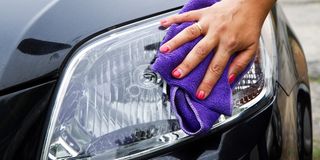How to restore your car headlights

You can restore your headlights by hand although it is more tedious.
What you need to know:
Headlight restoration is part of regular car maintenance. Knowing what needs to be done will save you money and time.
When the car is new, the headlights are normally as clear as glass. But after a while of driving, they change the colour to brown or yellow.
This, according to Lucky Jesse Kwesiga, a headlight restoring technician at Tango-7 Auto Centre in Entebbe, is as a result of oxidation. It is caused by ultraviolet rays from the sun. When these rays interact with plastic that is exposed to sunlight and heat over time, they cause oxidation and the brown or yellowish coating builds on top of the headlights.
Oxidation mostly affects modern car headlights that are made of hard plastic compared to cars whose headlights are made of glass.
“When the car comes out of the factory, a clear coat is put on top of the headlight and its main purpose is to protect the plastic from oxidation. Because of driving, washing, rain and other unavoidable factors, the protective coating wears out over a period of time and this is when the yellow and brown manifests,” Kwesiga explains.
The process of restoration
Headlight restoration is the process used to give your brownish headlights their initial bright light. According to Kwesiga, there are two products widely used to restore your headlights; T-cut and headlight restoration fluid.
Besides, removing stains from the car paint and scratches, T-cut also has the abrasion ability of removing whatever reacts with the car headlights. It is applied in sequentials as you use an orbit buffer because it gives you a consistent and clean light and the aftereffect is consistent and uniform compared to using hands where you apply T-cut as you buff or rub. This takes approximately 10-15 minutes to have a good job done.
There is also a proper headlight restoration kit that is rare in Uganda but can be imported. It comes with a liquid or restoration fluid that is specifically designed and made to remove the oxidation from the headlights.
“The fluid clears, restores and ensures that the headlight lasts longer compared to using T-cut. But even when you use T-cut, you have to apply polish and it is what most mechanics at your garage never do. They use T-cut and you are convinced that your light is clean and you drive away. After approximately a month or two, it oxidises again,” Kwesiga says.
Use polish after T-cut
When you use T-cut and apply polish after restoring the headlights, Kwesiga says it will last between six to eight months before you can restore the lights again. In six months, the coating will simply have gone off and it starts yellowing or browning slowly.
And in about eight months to a year, you will see the brown colour reappearing but the process would have started approximately six or four months ago.
“Headlight polish imitates the protective layer the manufacturer applies on headlights and gives it a much longer lasting period, while the headlight restoration solution ensures that your headlights go for upto a year and more months before you can restart the process again,” Kwesiga adds.
Restoring the rear lights
Isaac Mujjawa, a mechanic, says restoring rear lights is done using the same process used to restore headlights because the same material used to manufacture headlights is also used to manufacture rear lights. The difference is that rear lights do not show the brownish or yellowish dirt as the headlights because of the dull colours (red and sometimes orange) used with the rear lights.
“The oxidation happens on top of the light but not on the inside. The reason is that the light that comes from the bulb does not cause any impact on the light. It is the ultraviolet rays that causes the colour change as a reaction with the plastic chemical composition.
Replacing
Kwesiga and Mujjawa agree that to maintain the rear and headlights in their clear state, sometimes the bulbs have to be replaced.
There are rubber seals at the back end of these lights from which the bulbs are replaced.
These seals are always kept in good shape but when the bulbs are changed by someone unprofessional, they may sometimes tear the seals or put them back incorrectly and it allows air and water to find its way inside the headlight. This causes the light to become dirty on the inside.
“One way of cleaning such lights is removing the entire head or rear light and clean it with soap and water. Not all headlights are cleaned this way. There are those that are disposed of. Always make sure that all the seals at the back of either lights are in and well installed,” Mujjawa advises.
You will never avoid weather effects that cause oxidation, you just have to carry out a headlight restoration and it is part of car maintenance and keeping your headlights clear because clear lights ensure road visibility, especially when driving at night.




